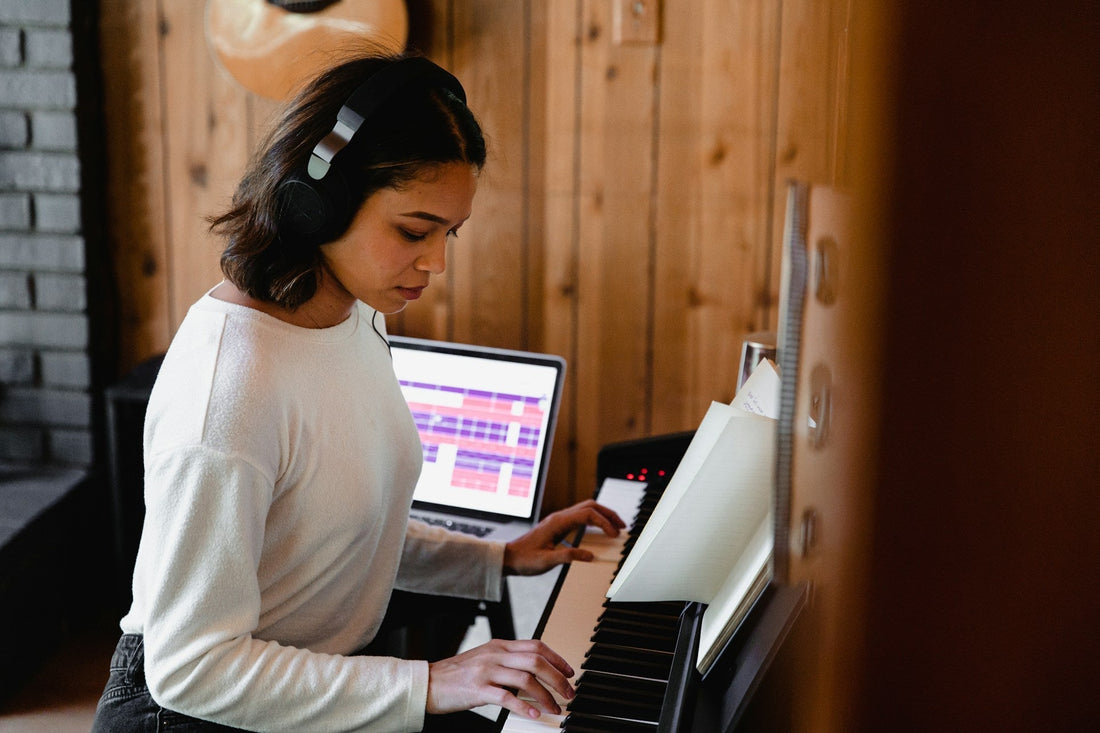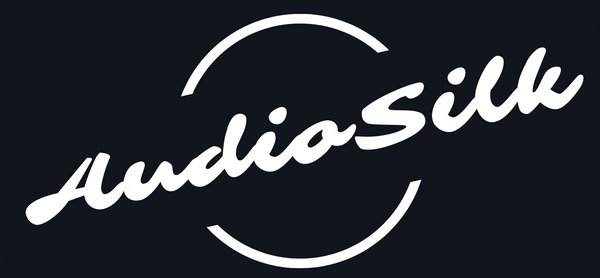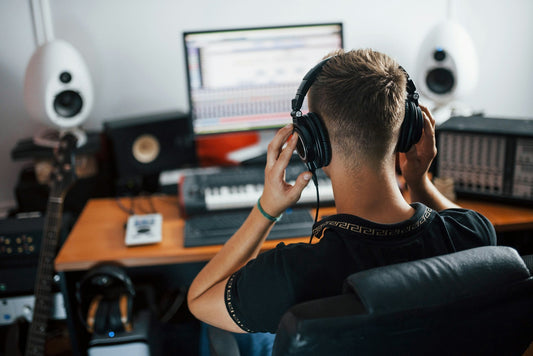
Musician Resume: The Complete Guide for Building Your Music Career
Aktie
Whether you’re just starting out as a musician, beat maker, or artist, or you’re backed by years of experience, the career of a musician is a dream come true for many.
You've spent years perfecting your craft, building your skills, and creating music that genuinely moves people. Your home studio setup is dialled in, your tracks are sounding professional, and you're ready to take your music career to the next level.
But then someone asks for your resume, and you freeze.
Wait a minute, do musicians even need resumes?
Aren't we supposed to let our music speak for itself?
The truth is, while streaming numbers and social media followers dominate the commercial music world, traditional musician resumes still open doors to opportunities that can make or break careers—orchestra positions, teaching jobs, session work, and grant funding.
Here's the reality: most musicians don't know when they need a formal resume versus when a digital portfolio works better.
Even worse, those who do create resumes often follow standard job resume rules that completely miss what music industry professionals actually want to see.
This guide cuts through the confusion.
We'll cover exactly when you need a musician resume, what makes them different from regular resumes, and how to build one that actually lands opportunities.
Whether you're eyeing that orchestra audition or building credibility as a session player, you'll know exactly how to present your musical experience professionally.
Do musicians really need resumes?

The short answer? It depends entirely on where you're headed in your music career.
Classical and orchestral musicians absolutely need resumes.
Major orchestras process their musicians with rigorous screening processes, with resumes included, that can last over a year with no guarantee of a job at the end of it.
In fact, some studies put the rejection rate of world-class orchestras as high as 99.5%, meaning they’re cast is really the 0.5% best in the world.
Again, these positions require formal documentation of your training, performance history, and professional experience in a very specific format.
Music educators can't escape them either.
University teaching positions, private school jobs, and even high-level private lesson studios expect detailed resumes highlighting your educational credentials, teaching philosophy, and student achievement metrics.
Music schools, including Juilliard and Berklee, require comprehensive resumes as part of their application process.
Session musicians find resumes incredibly valuable for studio work and professional collaborations. Studios want proof of your reliability, technical skills, and ability to work efficiently under pressure.
A well-crafted resume demonstrating your versatility across genres and your professional studio experience can be the difference between getting called back and being forgotten.
Grant applications and funding opportunities from organisations like the National Endowment for the Arts demand detailed artist CVs documenting your professional trajectory and artistic achievements.
However, if you're focused on touring, streaming, or building an independent music career, digital portfolios typically work better than traditional resumes.
Venues and promoters care more about your social media following, streaming numbers, and proven ability to draw crowds than your formal training.
Electronic Press Kits (EPKs), combining music samples, photos, and audience metrics, carry more weight in commercial contexts.
The key is understanding which tool serves your specific goals.
Why musician resumes break all the normal rules

Forget everything you know about standard job resumes—musician resumes operate in a completely different universe with their own logic and expectations.
Performance experience matters more than work history.
While regular resumes emphasise career progression and job responsibilities, musician resumes showcase where you've performed, who you've collaborated with, and what repertoire you've mastered.
A single performance with a renowned conductor or at a prestigious venue can outweigh years of routine gigs.
Your educational lineage carries serious weight.
In the music world, who you studied with often matters as much as where you studied.
Mentioning that you worked with a respected teacher or completed masterclasses with industry legends immediately signals your credibility to other professionals.
This concept barely exists in most other fields.
Length rules get thrown out the window.
Orchestra auditions demand strictly one-page resumes with no exceptions, while academic positions might require 2-3 page CVs detailing research, publications, and comprehensive performance histories.
Session musicians need concise one-pagers highlighting versatility, but classical musicians often maintain separate 2-3 page repertoire lists documenting every major work they've mastered.
Technical skills sections look completely different.
Instead of listing software proficiency and project management abilities, musician resumes feature instruments played, sight-reading capabilities, language skills for vocal music, and familiarity with different musical styles or periods.
Formatting expectations vary dramatically by genre
Classical musicians stick to conservative, black-and-white layouts that emphasise substance over style.
Contemporary musicians can incorporate more creative design elements, while music business resumes mirror traditional corporate formats but emphasise industry connections and revenue generation.
The bottom line: musician resumes prioritise artistic achievements, professional relationships, and technical mastery over traditional career metrics.
The 7 sections every musician's resume needs

So, you’ve decided that building a musician resume is the right choice to make for your preferred career. Now, where do you get started?
There are a few strategic sections and highlights you’ll want to include.
1. Header with musical identity
Your header needs more than just contact information. Include your name, primary instrument or voice type, phone number, email address, and links to your professional website or portfolio.
This immediately tells readers what kind of musician you are and how to reach you.
2. Performance experience (the heart of everything)
This section makes or breaks your resume. Organise performances by importance and venue type—solo recitals, orchestral works, chamber music, or contemporary collaborations.
Include venue names, dates, conductors or collaborators, and specific repertoire when relevant.
Quantify your impact wherever possible: "performed for audiences of 500+ at Lincoln Centre" carries more weight than simply "performed at Lincoln Centre."
3. Education and training
List conservatories, universities, degrees, and significant masterclasses in reverse chronological order. Include graduation dates, degree types, and any academic honours.
For classical musicians, this section often determines initial credibility with hiring committees.
4. Teachers and mentors
This uniquely musical section showcases your artistic lineage. List significant private teachers, masterclass instructors, and mentors who shaped your development. In classical music, especially, studying with respected teachers immediately signals your training quality.
5. Recordings and discography
Document your recorded work, including albums, singles, featured performances, and any commercial releases. Include record labels, chart positions if applicable, and streaming numbers for contemporary artists.
This demonstrates your professional recording experience and commercial viability.
6. Awards and recognition
Showcase competition results, scholarships, grants, and other recognition you've received. Include ranking information (first place, finalist, etc.) and the prestige level of each award. This section provides third-party validation of your abilities.
7. Technical skills and specialisations
List additional instruments, software proficiency (Pro Tools, Logic, etc.), language abilities for vocal music, and specialised skills like conducting, arranging, or music production. Contemporary musicians should include relevant technology skills and genre versatility.
How to build a musician's resume that gets you hired

Building a musician resume that actually gets you noticed isn't about listing every gig—it's about strategically showcasing what matters to the people making hiring decisions.
Step 1: Gather your complete musical history
Start by brainstorming every musical experience without filtering. Include all performances, educational experiences, collaborations, and achievements.
You'll edit this down later, but comprehensive initial documentation ensures you don't miss important details.
Create a master document with dates, venues, collaborators, and repertoire for easy reference.
Step 2: Choose your format based on your goals
-
Classical musicians should use reverse chronological formats, emphasising education and performance history. Conservative formatting with consistent fonts and spacing reflects the traditional expectations of orchestras and classical institutions.
-
Contemporary musicians benefit from skills-based layouts that highlight versatility and commercial achievements. Include metrics like streaming numbers, social media following, and audience sizes to demonstrate market viability.
-
Academic positions require CV-style formatting with detailed sections on research, publications, teaching philosophy, and comprehensive performance histories.
Step 3: Write descriptions that demand attention
Transform basic experiences into compelling professional narratives.
Instead of "played violin in orchestra," write "collaborated with 80-member symphony orchestra in performances of Beethoven's complete symphonic cycle, reaching audiences of 2,000+ over a six-concert series."
Use active language and specific details.
Mention recognisable venues, respected collaborators, and concrete numbers wherever possible. "Performed" is better than "played," and "mastered challenging repertoire including Paganini Caprices" is better than "played difficult pieces."
Quantify your impact consistently. Include audience sizes, venue capacities, student success rates for teachers, or streaming metrics for contemporary artists. Numbers provide concrete evidence of your professional impact.
Step 4: Tailor ruthlessly for each opportunity
Orchestra auditions require one-page resumes focusing exclusively on classical training and performance experience. Teaching positions need emphasis on educational background and student outcomes.
Session work demands highlighting versatility, reliability, and quick learning abilities.
Research each opportunity thoroughly. Classical organisations expect conservative presentation and comprehensive training documentation.
Contemporary venues prioritise audience development potential and commercial viability. Understanding these distinct expectations dramatically improves your success rates.
5 resume mistakes that make musicians unemployable
Even incredible musicians kill their own opportunities with amateur resume mistakes that scream "unprofessional" to industry gatekeepers.
Listing every minor performance instead of curating quality experiences
Hiring managers want to see your best work, not comprehensive documentation of every open mic night or community event. Include performances that demonstrate professional development, prestigious venues, or notable collaborators.
Quality beats quantity every time.
Writing generic descriptions without specifics or measurable outcomes
"Performed classical repertoire" tells readers nothing useful. "Mastered 20+ Mozart sonatas and performed complete Chopin Ballades in sold-out recital series" demonstrates specific technical abilities and proven audience appeal.
Inconsistent formatting that looks unprofessional
Mixed fonts, inconsistent spacing, varying date formats, and alignment issues immediately signal carelessness. Music industry professionals expect attention to detail in presentation just as much as in performance.
Failing to research position-specific requirements
Orchestra auditions have strict one-page limits with no photos or personal information. Academic positions expect detailed CVs with research components. Session work resumes should emphasise quick adaptation and genre versatility.
Misunderstanding these expectations wastes everyone's time.
Including irrelevant non-music experience without connecting it to musical value
Your retail job might have taught you customer service skills useful for teaching, but simply listing "Sales Associate, 2018-2020" adds nothing. Either connect previous experience to musical abilities or leave it out entirely.
Read this to wrap up
Your musician resume is your professional passport to opportunities that streaming numbers can't unlock.
While TikTok views matter for some gigs, traditional resumes still open doors to teaching positions, orchestral work, session opportunities, and grant funding.
The strategy?
Build both traditional and digital presence simultaneously. Maintain multiple resume versions—conservative one-pagers for orchestral auditions, comprehensive CVs for academic positions, metrics-focused docs for commercial collaborations.
Start with one targeted resume for your most immediate goal. Whether that's landing teaching gigs, auditioning for ensembles, or building session credibility, focus your initial effort where it can most directly advance your career right now.
But here's what separates serious musicians from hobbyists: professional-quality home recording capabilities.
Your resume lists your credentials. Your demo recordings prove your talent. But if those recordings sound amateur because of poor room acoustics, even perfect qualifications won't save you.
AudioSilk acoustic panels ensure your audition materials, demos, and collaborative projects sound as professional as your resume looks. No more losing opportunities because your home recordings don't match your actual skill level.
The combination of formal credentials and professional recording quality positions you for success across every musical context.
Ready to sound as good as you look on paper?
Get AudioSilk panels and make sure your recordings match your resume's professionalism.
Use code BLOG10 for 10% off your professional setup →
Your music career deserves a professional presentation—both on paper and in every recording you share.



